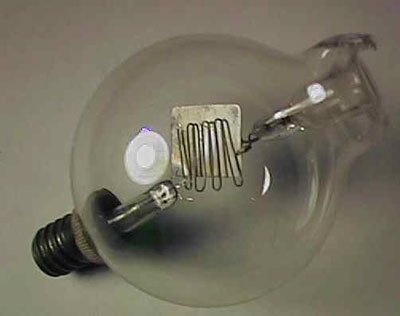
 |
Search | FAQ | US Titles | UK Titles | Memories | VaporWare | Digest | |||||||
| GuestBook | Classified | Chat | Products | Featured | Technical | Museum | ||||||||
| Downloads | Production | Fanfares | Music | Misc | Related | Contact | ||||||||
| CED in the History of Media Technology | ||||||||||||||

Lee De Forest invented the Audion vacuum tube in 1906, which went on to become the most significant electronics innovation of the first half of the 20th century after its application to radio was understood and perfected. The vacuum tube actually originated with Thomas Edison's invention of the electric light bulb. In experiments conducted in 1883 Edison noted that electric current would flow from the bulb filament to a positively charged metal plate inside the tube. But this was 15 years before the discovery of the electron (by J.J. Thomson), so no one understood the significance of what was going on. The phenomena came to be called the "Edison Effect," and Edison patented it as a potential current measuring device, as the flow of current was proportional to the incandescence of the bulb.
An Edison Co. employee named John Fleming conducted further experiments on the Edison effect until 1896, when he was diverted to other work. In 1904 he resumed work on the lamp as a potential detector of wireless waves while an employee of the Marconi Co. Fleming made a discovery that had previously been missed. The alternating current being applied to the bulb filament was leaving the tube (via the metal plate) as direct current. This tube was called the Fleming Valve and its ability to rectify AC current was used in the Diode tubes that followed (and the same concept applies to silicon diodes today).
Lee De Forest built on the work of Edison and Fleming by modifying the tube so it could not simply rectify AC current but amplify it. The De Forest Audion contained the filament and plate of the Fleming valve, but interposed between them was a zigzag wire called the grid. A small electric current applied to the grid would result in the proportionate flow of a much larger current from the filament to the plate- in other words amplification. The Audion became know as the Triode and was the standard means of amplification until it was gradually replaced by the transistor in the 1950's and 60's. Without the Audion, inexpensive amplification of wireless voice transmissions would not have been possible, and Radio Corporation of America would have been a significantly different enterprise.